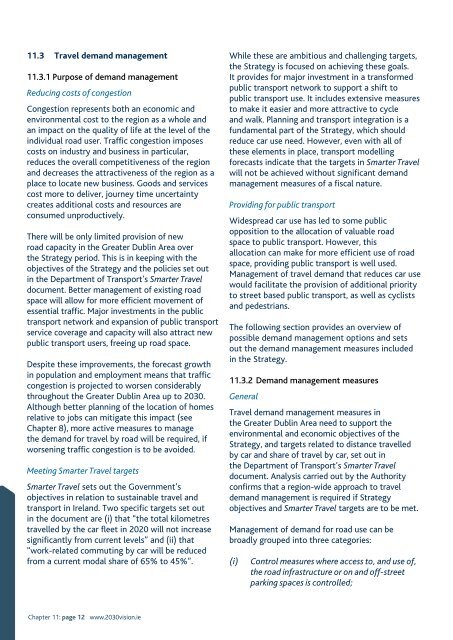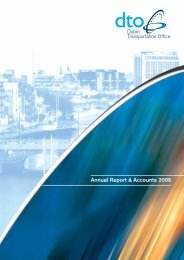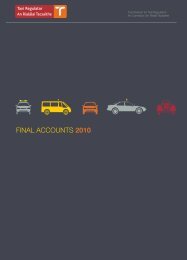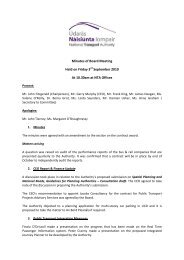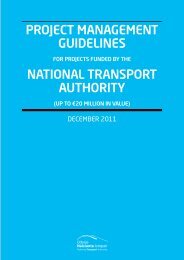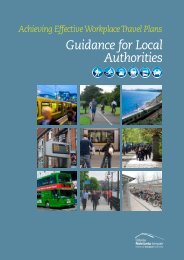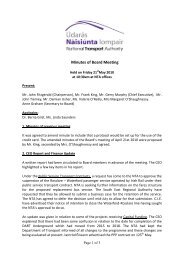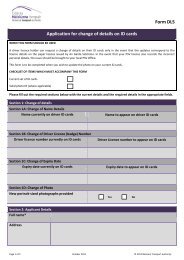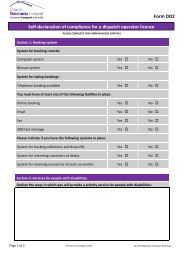Greater Dublin Area Draft Transport Strategy 2011-2030
Greater Dublin Area Draft Transport Strategy 2011-2030
Greater Dublin Area Draft Transport Strategy 2011-2030
- No tags were found...
You also want an ePaper? Increase the reach of your titles
YUMPU automatically turns print PDFs into web optimized ePapers that Google loves.
11.3 Travel demand management11.3.1 Purpose of demand managementReducing costs of congestionCongestion represents both an economic andenvironmental cost to the region as a whole andan impact on the quality of life at the level of theindividual road user. Traffic congestion imposescosts on industry and business in particular,reduces the overall competitiveness of the regionand decreases the attractiveness of the region as aplace to locate new business. Goods and servicescost more to deliver, journey time uncertaintycreates additional costs and resources areconsumed unproductively.There will be only limited provision of newroad capacity in the <strong>Greater</strong> <strong>Dublin</strong> <strong>Area</strong> overthe <strong>Strategy</strong> period. This is in keeping with theobjectives of the <strong>Strategy</strong> and the policies set outin the Department of <strong>Transport</strong>’s Smarter Traveldocument. Better management of existing roadspace will allow for more efficient movement ofessential traffic. Major investments in the publictransport network and expansion of public transportservice coverage and capacity will also attract newpublic transport users, freeing up road space.Despite these improvements, the forecast growthin population and employment means that trafficcongestion is projected to worsen considerablythroughout the <strong>Greater</strong> <strong>Dublin</strong> <strong>Area</strong> up to <strong>2030</strong>.Although better planning of the location of homesrelative to jobs can mitigate this impact (seeChapter 8), more active measures to managethe demand for travel by road will be required, ifworsening traffic congestion is to be avoided.Meeting Smarter Travel targetsSmarter Travel sets out the Government’sobjectives in relation to sustainable travel andtransport in Ireland. Two specific targets set outin the document are (i) that “the total kilometrestravelled by the car fleet in 2020 will not increasesignificantly from current levels” and (ii) that“work-related commuting by car will be reducedfrom a current modal share of 65% to 45%”.While these are ambitious and challenging targets,the <strong>Strategy</strong> is focused on achieving these goals.It provides for major investment in a transformedpublic transport network to support a shift topublic transport use. It includes extensive measuresto make it easier and more attractive to cycleand walk. Planning and transport integration is afundamental part of the <strong>Strategy</strong>, which shouldreduce car use need. However, even with all ofthese elements in place, transport modellingforecasts indicate that the targets in Smarter Travelwill not be achieved without significant demandmanagement measures of a fiscal nature.Providing for public transportWidespread car use has led to some publicopposition to the allocation of valuable roadspace to public transport. However, thisallocation can make for more efficient use of roadspace, providing public transport is well used.Management of travel demand that reduces car usewould facilitate the provision of additional priorityto street based public transport, as well as cyclistsand pedestrians.The following section provides an overview ofpossible demand management options and setsout the demand management measures includedin the <strong>Strategy</strong>.11.3.2 Demand management measuresGeneralTravel demand management measures inthe <strong>Greater</strong> <strong>Dublin</strong> <strong>Area</strong> need to support theenvironmental and economic objectives of the<strong>Strategy</strong>, and targets related to distance travelledby car and share of travel by car, set out inthe Department of <strong>Transport</strong>’s Smarter Traveldocument. Analysis carried out by the Authorityconfirms that a region-wide approach to traveldemand management is required if <strong>Strategy</strong>objectives and Smarter Travel targets are to be met.Management of demand for road use can bebroadly grouped into three categories:(i)Control measures where access to, and use of,the road infrastructure or on and off-streetparking spaces is controlled;Chapter 11: page 12 www.<strong>2030</strong>vision.ie


